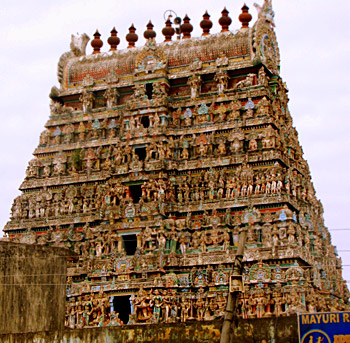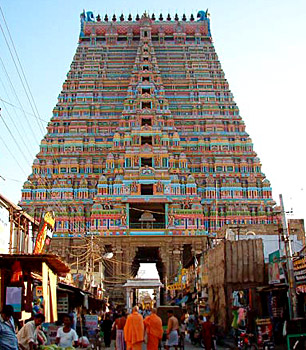 Fine arts of South Indian Temples pinpoint to the very primarily those in the South are the repositories of fine arts. These temples have been a place of all cultural activities and they have supported and patronized the artists` community and artisans for a long time.
Fine arts of South Indian Temples pinpoint to the very primarily those in the South are the repositories of fine arts. These temples have been a place of all cultural activities and they have supported and patronized the artists` community and artisans for a long time.
The viewers and the listeners could enjoy the charm of these fine arts without paying a single penny in these temples. It was entertainment, education and enlightenment of the mind and spirit. These offered the charm of the arts to the people of varying tastes and levels of knowledge.
Many kingdoms came into rule in South India but the native people protected its temple infrastructure ardently. Hence maximum of the temples have survived till today. Almost all the South Indian cities and villages had small and large temples, which date back to many hundreds of years. In these temples, ritualistic worship of the deity is done by sixteen offerings, which are known as `Shodasopachara`. Dance and music was an important part of these worships.
The puja is performed six times a day in these temples. Every temple used to have a nagaswaram ensemble, known as peria melam nand it was played during the pujas. The procession is indicated by the majestic Mallari, different for each God and occasion, played by the nagaswaram party. Maharaja Swati Tirunal had the collection of songs, which were sung at the Padmanabha temple at Thiruvananthapuram during the daily Seevelis (procession in the temple corridors) and on festive occasions.
There used to be the oduvars (the ones who used to recite) for the Siva temples of South India. They used to sing hymns from the The varam in the traditional panns (ragas). This tradition was passed from generation to generation of their families. There were also devadasis in these temples, who used to perform dance during daily rituals inside the temple, and during processions outside the temple. But they were banned in the 20th century. Each temple had one or more devadasis. In the Brihadishvara temple built by Rajaraja I, the Chola emperor in the 11th century, had more than 400 devadasis, who were employed by the temple. The colony near this South Indian temple was called Thalichery (the temple colony) and its residents were known as Thalichery pendir. The families of nattuvanars (male dance teachers and conductors) from the temples of Pandanallur, Thiruvidaimarudur, Vazhuvoor, Vaideeswaran Koil, etc, used to live there.
There is a unique fine arts of temples of Tamil Nadu is the Araiyar Sevai. It was a type of music and abhinava ritual done by men belonging to the families of Araiyars, The temples of Srirangam, Srivilliputtur and Srivaikuntam in Tamil Nadu and Melkote in Karnataka had these Araiyar Sevai. The Araiyar families have carried on this tradition through heredity.
In Srirangam temple, there are families, whose men play the veena late at night at the sanctum sanctorum, when the Lord goes to sleep. This service is known as Veenai Ekaantam and it is a hereditary right of the families. In the temples of Kerala, Koodivattam and Nangyar Koothu are performed. Krishnanattam is a derivative of Kathakali and is a dedicated offering at the temple at Guruvayoor. At that time, dance and music were considered yoga and vehicles to refine the mind through concentration, meditation and a total involvement in the beauties of sound and movement.
 The gods and the goddesses of the temples themselves were dancers and musicians. Narthana Ganapathi, Lord Krishna used to perform, Parvathi offered the `lasya` form of art to mankind and finally Nataraja, the dancing form of Siva, typify the sublimity of dance.
The gods and the goddesses of the temples themselves were dancers and musicians. Narthana Ganapathi, Lord Krishna used to perform, Parvathi offered the `lasya` form of art to mankind and finally Nataraja, the dancing form of Siva, typify the sublimity of dance.
Krishna with his flute, Sarasvathi, Narada and Parvathi with their respective veenas Lord Shiva with his damaru and Nandi with his mridangam, symbolise the divinity of Nada Toga. They were unique form of arts of these temples.
Every South Indian temple had a Harikatha or Pravachana or Bharatha mantapam, which is a raised platform with a canopy in the open spaces near the main temple. These were meant for pauranikas or kathakars (story tellers), which explained the great epics and the Indian Puranas to the common folk. These art forms of the South Indian temples brought the religious literature to the people in interesting modes.
These South Indian temples also played the role of academies, where a new work of literature would be given the stamp of approval by the learned persona of the land. It is said that the Tiruvalluvar`s Tirukkumal was set on the `sanga palagai` and was floated in the temple tank at Madurai, Tamil Nadu. Kumaraguruparar recited his verses on Meenakshi at her temple for the first time and an incident signified the acceptance of the Goddess. In the Srirangam temple, Kambar and Arunachala Kavi recited their Ramayana verses. The `Divya Prabandam` were the verses of the `Sathumurai` recitation and this art form were performed in all Vaishnavite temples of South India.
In the temples of Kerala, reading Ramayana in the months of July-August was a regular ritual. These South Indian temples also contained art galleries for paintings, such as the Chola paintings at the Brihadishvara Temple. Maithuna (erotic) paintings and sculptures are part of the temple art, representing life as a whole without prudery and Puritanism. The Chola bronzes of gods and goddesses, cast as utsara berams (processional icons) have won acclaim in the international art circles.
The art of iconography, making of ornate metal lamps, utensils and artifacts boomed in the temples and the creativity infused the society in every household article. There were woodcarvings following the models of stone sculptures, usually on a smaller scale in these South Indian temples. These were carved on temple cars called rathas. Some of the temples, like the recitation mantapam at the Srivilliputtur temple were decorated with this type of carvings. There were also other types of arts and crafts like making of garlands and floral decorations that added colour and beauty to the temple ambience. The Andal garland of Srivilliputtur and the parrot made of leaves were the craft of a family, which pursues it as a hereditary right.
Through out the year, lots of artists and artisans used to remain in the temple and used to provide art materials to the visitors. Besides the competition factor, these artists had a spirit of dedication to the deity of the temple, which encouraged them to come out with new ideas and excel in his sphere. The best creation of art was offered to the Almighty, from whom the inspiration came.











